Measurements of the switching supercurrent statistics of a superconducting quantum interference device based on bismuth, a second-order topological insulator, reveal that excited Andreev states are surprisingly long-lived
Second-order topological insulators (SOTIs) are crystals with helical states at their hinges, meaning that on one hinge right-moving electrons have a given spin (say, spin-up), and left-moving electrons have the opposite spin (spin-down). Right-movers with down spin (and left-movers with up spin) are located on the opposite hinge. It is therefore natural to ask whether SOTIs carry supercurrent in a different way to non-topological crystals with spin-degenerate states.
We previously found that a bismuth-based Josephson junction could carry a supercurrent ballistically (with no backscattering) over more than 1 μm (ref. 1). This robustness to disorder led to the discovery that bismuth was a SOTI2, and the prediction that topologically protected helical states exist at the hinges of the crystal. However, no signature of spin–momentum locking, which is characteristic of helical states, was observed, leaving the question of the helical nature of these edge states unresolved.
Here, we found that observations of the dynamics of the supercurrent in a bismuth-based Josephson junction can be used to study the helical hinge states. A ring-shaped bismuth nanocrystal was connected to two superconducting electrodes to form an intrinsic superconducting quantum interference device (SQUID) (Fig. 1). The largest supercurrent that can flow in the SQUID, called the critical current, is primarily determined by the branch of the ring with the largest critical current, with the addition of a small, flux-dependent contribution due to the supercurrent through the other, ‘weak’ branch of the ring with the smallest critical current. Thus the critical current of the SQUID reveals the supercurrent through the weak branch, and can be used to infer the number and energy of the occupied Andreev bound states in that branch
Rather than the critical current, in an experiment, we measure the slightly smaller ‘switching current’ — the current at which the SQUID switches to a dissipative state through a stochastic process. By measuring the statistical distribution of the switching current as we swept the biasing current, we found that the supercurrent in the weakest branch was carried by Andreev bound states in two separate channels. Moreover, these states were not always both in the ground state, but there were measurable probabilities of finding one channel in the ground state and the second in the excited state, and even a finite probability of finding both Andreev channels in an excited state. This discovery was a surprise, because at the relatively slow (sub-kilohertz) rate at which we swept the current, we expected to find only the lowest-energy Andreev states to be populated. Using a phenomenological model inspired by previous studies3, we extracted the rates at which Andreev states relax independently and the rate at which two Andreev states from separate hinges relax together. This pair relaxation, which occurs on a millisecond timescale, is almost 1,000-times slower than the pair relaxation rate in non-topological Josephson junctions, in which the Andreev states are spin-degenerate and not helical. We attribute this slow pair relaxation to weak coupling between the Andreev states on different hinges, and consider this to be an indication of the helical nature of the hinges.
The work has been published in Nature Physics.
